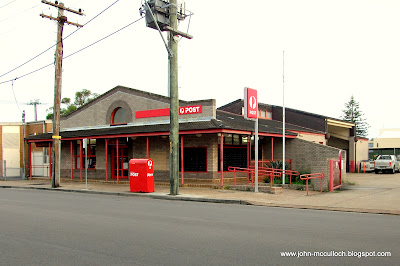It was the death of one the local coal mining ventures that eventually became the catalyst for the settlement of Pelican Flat.
When the New Wallsend Mining (Coal) Company, located at Catherine Hill Bay (NSW) collapsed in hard financial times in March 1876, the township supporting the mine started to die off as well and so on the 3rd September 1879, the then Catherine Hill Bay postmaster, Mr Robert Talbot, requested that he move the Post Office to the settlement that had grown around the entrance to Lake Macquarie. After an inspection by the Postal Inspector, where he found all that was left at Catherine Hill Bay was basically three men and a lazy dog, he agreed to move the Post Office to the new settlement of Pelican Flat, so on the 1st December 1879, Mr Talbot officially became the Postmaster of Pelican Flat.
In 1887 the residents petitioned the NSW Colonial Government to change the name to Swansea to reflect the growing confidence of the community and so on 1st November 1887 Postmaster-General, officially approved the change of name. The name Pelican Flat was quickly discarded to the history books
.jpg) Despite the community having a Post & Telegraph Office, Police Station, Public School, Pilot Station, Harbour & Rivers Department, hotel and other supporting businesses, the Post Office operated at a loss, in 1887 the balance sheet looked like this;
Despite the community having a Post & Telegraph Office, Police Station, Public School, Pilot Station, Harbour & Rivers Department, hotel and other supporting businesses, the Post Office operated at a loss, in 1887 the balance sheet looked like this;Revenue - £91.14.11
Costs - £160
So on the 2nd August 1888, Swansea Post Office was downgraded to a non-official Post and Telegraph Office, Mr Gywnne was posted to Carrington and the telegraph equipment was sent to Belmont (along with the assistant morse operator, Mr Williamson). This put Mr Talbot back in charge of the Post Office, with he and his wife Annie holding this position until February 1897, when ill health forced the sale of the Post Office.
The sale of the Post Office resulted in the first of many changes, as each new Postmaster/Postmistress, moved the Post Office to their business or in some cases, to their own private residence, but it was always along Main Street.
Then in 1948, due to the increasing population, approximately 3,000 permanent residents (swelling to 5,000 during the holiday season), Swansea, on the 7th December 1948, once again became an Official Post Office. However, the 'new' Post Office staff had to wait until 1958 to get a building of their own.
 That building, a former billiard hall at, No. 5 Lake Road, served Australia Post until they unveiled their brand new $462,000 building (at No.7 lake Road) on the 17th November 1986, with the former being demolished to facilitate the new site works. The current Post Office (the 6th) was, at the time, cutting edge design and reflected the image the Australia Post was projecting to the community during the 1980's, that it was a vibrant 'in touch' organisation on the move.
That building, a former billiard hall at, No. 5 Lake Road, served Australia Post until they unveiled their brand new $462,000 building (at No.7 lake Road) on the 17th November 1986, with the former being demolished to facilitate the new site works. The current Post Office (the 6th) was, at the time, cutting edge design and reflected the image the Australia Post was projecting to the community during the 1980's, that it was a vibrant 'in touch' organisation on the move. Swansea Post Office is still an important hub of the local community and is still basically performing the same essential service that Mr Talbot commenced at Pelican Flat over 130 years ago!
I would like to thank George Boyd, LMCC Library & The East Lake Historical Society Inc. for all their patience & assistance in helping me compile this blog.


No comments:
Post a Comment